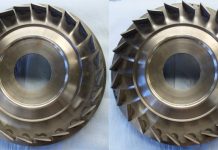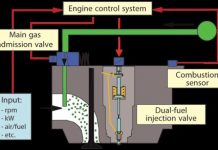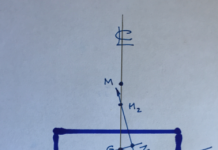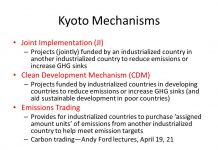Introduction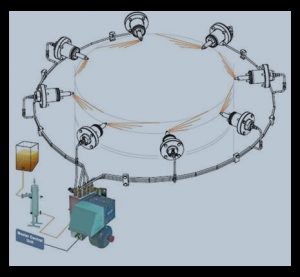
Cylinder lubrication is an accessory applied to facilitate the operation of a two- stroke crosshead diesel engine. Failure in operation may cause considerable damage and can render an engine inoperative. All four cylinder lubrication systems described and considered below are assumed capable of performing their function with satisfactory stability and reliability, to be relevant in search of efficiency.
Many factors affect the condition attainable with proper cylinder lubrication, also in establishing what proper cylinder lubrication at a given situation is. This is mirrored in the rather flexible specifications of guiding feed rates from the engine designers and engine builders, and the deviations from these in actual engine operation.
As conditions for different engine installations vary considerably, conclusions on efficiency evaluations may differ when it comes to the choice of cylinder lubrication system. In that light comparisons between systems are excluded, but features affecting operating efficiency are presented.
Cylinder lubrication is performed for several reasons, which are here listed in the order of importance:
- Reducing friction between piston rings and liner wall
- Neutralizing acid
- Sealing between piston rings and liner wall
- Cleaning, by carrying away wear, fuel and lubricant debris
In light of traditional shipowner focus on low liner wear, and as both Wärtsilä and MAN B&W specify corrosion as the major cause of liner wear, acid neutralization must be given highest priority for attaining efficiency in normal operation.
In the following, the abbreviation CLS shall be used for the term Cylinder Lubrication System. The abbreviation CLO shall be used for the term Cylinder Lubrication Oil.
Systems described
To provide an initial overview, the CLSs presented in the following are shortly grouped and 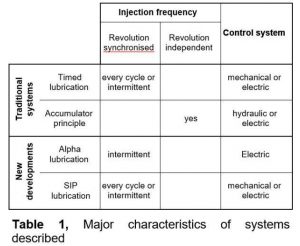 introduced in Table 1, listing their major characteristics. The focus is on two traditionally applied systems, and two new developments, each with their individual design and functional features.
introduced in Table 1, listing their major characteristics. The focus is on two traditionally applied systems, and two new developments, each with their individual design and functional features.
Traditional Systems
Predominantly in the past, there have been two CLSs, based on Timed Lubrication (MAN B&W & MHI) and on Accumulator Lubrication (Wärtsilä [Sulzer]) respectively.
Common for these systems has been the injection of CLO in drops to be distributed over the surface of the liner through a circumferential zigzag groove, as the pressure difference over the piston rings presses the oil to move in the groove, and vertically distributed by the movement of the piston rings as illustrated in fig. 1.
Fig. 1, Principle for traditional distribution of cylinder oil on the cylinder liner wall
The effectiveness of the method is confirmed through the many years of application, but the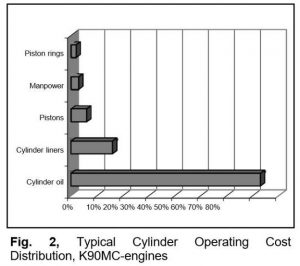 efficiency can be questioned based on absolute CLO consumption increase over the years and the cost distribution seen in fig. 2.
efficiency can be questioned based on absolute CLO consumption increase over the years and the cost distribution seen in fig. 2.
Fig. 2, Typical Cylinder Operating Cost Distribution, K90MC-engines
Timed Lubrication
The purpose of timed lubrication, as shown in fig. 3, is to deliver CLO to the sliding surfaces in the cylinder at a specific time in relation to the position of the diesel engine piston during its upward movement:
The oil is pumped into the cylinder when the piston rings pass the lubricating orifices, during the upward stroke. (MAN B&W project Guide 1987).
Fig. 3, Timed Lubrication
Timed lubrication as described above is in practice carried out by means of lubricators driven mechanically from and synchronously with the diesel engine. Thelubricators are connected by means of couplings and intermediate shafts to the diesel engine drive, so that CLO is supplied at every diesel engine piston stroke and at the specific time in the diesel engine cycle.
The CLO quantity delivered from the lubricators can be adjusted manually and/ or automatically. The oil is supplied through non-return valves to the diesel engine cylinder, where the piston rings distribute it to the cylinder liner surface. To attain the aim of correctly timed lubrication with mechanical lubricators the possible “accumulator” effect in the supply tube from the lubricator pump to the injection valve in the liner wall has to be considered. If the supply tube is kept under a sufficient pressure by the counter pressure in the non-return valve, the desired injection timing is achieved.
If the non-return valve pressure is insufficient – as for most engine applications today – the above-specified requirement to timing is not attained in practice.
For timed lubrication, various methods have been applied to attain a higher degree of efficiency than the basic CLS design includes. Of these can be mentioned: MEP/BHP dependent regulation, LCD regulation, Intermittent lubrication etc. In short, these possibilities can be described:
MEP/BHP denotes an adjustment of the stroke in the lubricator oil pumps to correspond to the mean effective pressure or the actual engine load. The system is a natural consequence of specifying the required CLO consumption as a function of engine load defined as g/kWh. Load dependent regulation, is applied with advantage on many rpm-dependent engines, but has “only” found general application on engine installations with fixed rpm.
LCD is short for Load Change Dependent, and is a method of increasing CLO injection for short time periods, when thermal instability in the cylinder due to load changes may cause exceptionally high risk of corrosive and frictional wear. Increased injection of oil is desired at these times to neutralize acid build-up and reduce friction. Increased lubrication at manoeuvring, engine stop and start, works as a kind of conservation and priming.
With Intermittent Lubrication is meant an adjustment of the frequency (and quantity) of injection to meet the engine’s presumed actual need for lubrication, i.e. injecting more CLO at longer intervals than at every engine revolution; the frequency of injections with intermittent lubrication can be determined by signals from sensors, an algorithm or a pre- determined frequency.
Only few engines have been equipped with this solution. Even fewer have operated with the system in use, due to insecurity as to validity of signals from applied control system.
Accumulator Lubrication
With accumulator lubrication, as shown in fig. 4, injection of CLO takes place when the pressure in the cylinder off the non- return valves is sufficiently low. I.e. when the pressure is smaller than the pressure in the accumulator or the non-return valve, CLO is delivered. This way of controlling the oil delivery means that it is delivered above, on or under the piston rings.
Accumulator lubrication on Sulzer engines takes place at two levels in the cylinder liner, which, all things being equal, will give a better distribution of the CLO on the cylinder surface than if it had been delivered to only one lubrication level. As the lubrication is asynchronous with the diesel engine piston position, the lubricators can be driven by an engine independent drive e.g. with a hydraulic or an electric motor.
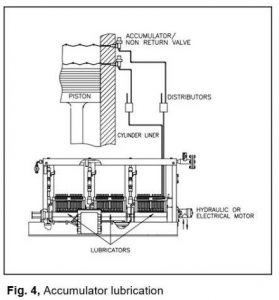
Fig. 4, Accumulator lubrication
The CLO, which is delivered from each lube point in the lubricator, is divided by a distributor to more accumulators in the cylinder, however, in such a way that all the oil from one lube point is distributed to the same lubrication level. Thereby it is possible to lubricate with different quantities in the various lubrication levels. This is desirable in order to distribute the CLO best possible according to the assumed need.
The system allows pre-lubrication of the cylinder, as the lubricators can be operated independent from the engine revolutions. Likewise, in operation the asynchronous drive allows load dependent quantity adjustment by regulating the pumping frequency of the cylinder lubricator.
Cylinder Lubrication in Future Perspective
Recent years have seen actions towards solutions in line with today’s understanding of the technology and efficiency requirements. In our view, this process is far from finished.
Below is described two new CLSs. They have completely different backgrounds and intentions for the development process.
Achieved with both is an improvement in efficiency, but the coming challenge shall be to look at conventional principles such as:
- Is the efficient consumption of CLO necessarily (and only) a function of engine load defined as g/kWh, or should other factors such as absolute engine load and cylinder liner surface area be included in the calculation?
- What is the optimal trade-off between CLO consumption and cylinder liner wear rate?
- Can one of the existing or a completely new CLS in combination with a new constellation of influencing factors achieve even higher level of efficiency than the one used as criteria for this paper?
- Is BN (base number) in “scrape down” a sign of actual acid neutralization?
The process of re-evaluation of established truths has begun, but is far from completed.
Important factors “outside” the CLS influencing the over-all cylinder lubrication efficiency are in alphabetical order:
- Application of anti polishing ring
- Cylinder liner temperature
- CLO composition & contamination
- Engine operating load profile
- Fuel oil composition & contamination
- Humidity of scavenging air
- Liner material and execution
The challenge lies in the ability to distinguish, prioritise and limit the number of factors and parameters considered in the future development to the ones actually providing measurable efficiency improvements in practical application
New CLS Developments
Development in the field of cylinder lubrication has begun, sparked by different factors. The two most important ones being:
- A desire to achieve better timing
- A desire to cut operating costs (achieve efficiency)
The introduction of common rail systems on the engines and thereby the exclusion of camshafts may initially be seen as a similar factor to do so. This, however, is not correct, as there are several ways of establishing a lubricator drive, meeting the needs for applying CLSs of traditional type as described above. This is for example confirmed on the RTA-Flex engines where accumulator lubrication is applied.
Alpha Lubrication
Alpha lubrication is an electric/hydraulic lubrication system, dosing the CLO timed to the diesel engine cylinder, with the lubricators being driven electrically synchronized with the diesel engine.
Fig. 5 shows schematically the principle of the Alpha lubrication system.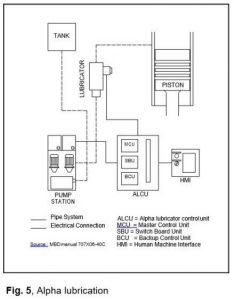
Fig. 5, Alpha lubrication
Alpha lubrication is based on the principles of timed lubrication, but is performed with new equipment developed to improve the timing based on the philosophy that an improved timing gives possibilities for saving cylinder oil.
The system is presented with the following information (fig. 6) about the superiority in performance compared to conventional timed lubrication. I.e. Alpha lubrication alleviates shortcomings of proper injection timing due to non-return valve design in conventional timed lubrication, and thereby provides possible reduction in recommended CLO consumption.
Fig. 6,Measured pressure in the lubricating oil quills and timing of lube oil injection (Source: The Intelligent Engine Development Status and Prospects.)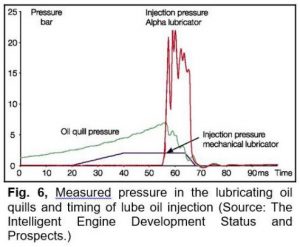
The timing is determined based on signals indicating the position of the diesel engine crankshaft. These signals are processed by a programmed control unit ALCU (consisting of the units MCU, SBU, BCU and HMI as described in fig. 6). As the timing is executed with electric signals, it is possible to change the injection timing as the engine is running. The injection of the CLO is controlled by a solenoid valve directing the pressure from the pump station to the lubricators.
Each lubricator is equipped with more supply pistons, which supplies a fixed pre- adjusted quantity per injection. As the lubrication is timed, the total lubrication quantity is controlled by the number of diesel engine revolutions during which injection is skipped. Lubrication typically takes place during each 4th to 7th diesel engine piston stroke. I.e. intermittent lubrication is applied.
The non-return valves are equipped with two holes horizontally, one at each side, which delivers the CLO tangentially with the cylinder surface. CLO is injected onto the piston rings, which in turn distribute the CLO to the cylinder surface as for timed lubrication.
The regulation of the CLO quantity can be made based on various parameters, e.g. engine load, engine rpm etc. If the Alpha lubrication system is equipped with Alpha Adaptive Cylinder Oil Control, ACC, regulation can be made based on the sulphur content of the fuel oil.
The application of electronics and hydraulics in Alpha Lubrication gives and takes flexibility. It is possible to apply sophisticated algorithms for calculating proper CLO quantity, but at the same time, the possibility of injecting fresh (alkaline) CLO at every engine revolution does not exist.
Swirl Injection Lubrication (SIP)
As introduced at the CIMAC conference in Hamburg May 2001, the Swirl Injection Principle (SIP lubrication) system was developed based on a desire to attain operating efficiency based on a re-thinking of the application and not least the use of the CLO.
The principle is not tied to the technology of timing and dosing the CLO, but to how the oil is distributed on the cylinder liner wall, in order to give a good circumferential distribution and an adequate (alkaline) oil film with as little oil as possible.
Fig. 7, HJ SIP Lubrication System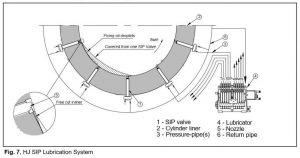
Applying lubricators similar to solutions for conventional timed lubrication – but with pressurized valves and spray nozzles instead of conventional non-return valves in the liner wall – it is made possible to inject a spray of droplets tangentially to the cylinder liner wall. This allows (with proper injection timing) an oil film to develop over a horizontal section of the liner wall before the piston rings pass in the upward movement and take care of the final vertical distribution. As distribution takes place by spraying the oil to the cylinder surface, the traditional zigzag groove is no longer necessary. Instead, a small injection groove is required to allow the cylinder oil to pass on its way to the cylinder liner wall. Please refer to fig. 7.
When injecting the spray of CLO droplets timed just after closure of the exhaust valve, and while a steady scavenging air flow still exists, the swirl carries the droplets to settle on the liner wall as desired, and no emission of oil mist takes place. Please see fig. 8.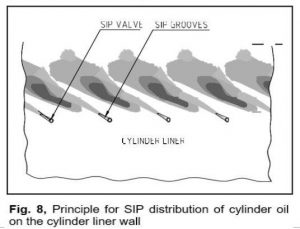
Principle for SIP distribution of cylinder oil on the cylinder liner wall
Delivery of overlapping sprays of CLO to effectively cover the circumference of the upper part of the cylinder liner, before the passage of the piston rings is intended, as the wear is normally larger at the top of the cylinder liner. This is achieved without “starving” the lower part, piston rings and piston ring grooves.
SIP lubrication is based on delivery of fresh CLO at every diesel engine piston stroke to have fresh alkalinity to neutralize acid from the combustion of the sulphurous fuel.
The SIP valves (fig. 9) are designed according to the same principles as traditional fuel valves. 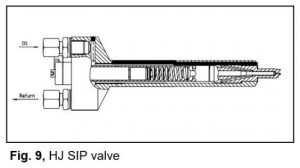 As the pressure in the oil column from the lubricator and to the injection valve is decisive for, when the oil pumped from the lubricator is injected to the cylinder liner, the counter pressure is considerably higher than for the non- return valves applied with conventional timed lubrication. SIP lubrication is applicable irrespective of engine design.
As the pressure in the oil column from the lubricator and to the injection valve is decisive for, when the oil pumped from the lubricator is injected to the cylinder liner, the counter pressure is considerably higher than for the non- return valves applied with conventional timed lubrication. SIP lubrication is applicable irrespective of engine design.
HJ SIP valve
SIP lubrication is applied based on the principles shown in fig. 10 and fig. 11. As can be seen from the system design, either a mechanical connection or an electric shaft can provide the synchronization between the crankshaft movement and the timing of the cylinder lubricator pumping.
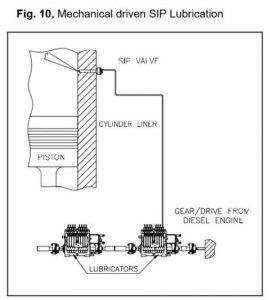
Fig. 10, Mechanical driven SIP Lubrication
The challenge will be to maintain operating efficiency as the aim for the future.

Fig. 11, Electrical driven SIP Lubrication
To shed the limitations of a purely mechanical cylinder lubricator to feed the oil to the injection valve of the SIP system, R&D is ongoing to provide further possibilities. It is too early, however, to go into details and establish if such new ideas will actually bring considerable efficiency advantages. It will, however meet possible requirements for having an alternative based on new-technology-application.
Efficiency and Equipment Selection
The CLS developments add complexity to the selection of system to be applied, but also give previously unknown possibilities for achieving the sought efficiency based on a case-by-case evaluation. Additionally it gives a platform from which to influence and support further developments in the field.
New functions and new equipment may induce shipbuilders, -owners and – managers to change attitude towards cylinder lubrication. Maybe reductions in CLO consumption can even justify shorter lifetime to wear components such as piston rings and cylinder liners, everything else being equal. The recent developments may just have scratched the surface of completely new possibilities.
Hans Jensen Lubricators A/SManufacturer of cylinder lubrication equipment since 1923, HJL is approved supplier of CLS equipment to MAN B&W, Mitsubishi and Wärtsilä 2-stroke slow speed crosshead diesel engines.
With due consideration to customer confidentiality, a considerable and broad expertise has been attained in the field of cylinder lubrication systems. This experience is applied to all new developments and in our advisory functions, to the benefit of our business partners.
HJL has been and aims at remaining in the forefront of development in the field of cylinder lubrication. With a total staff of 50 employees entirely devoted to the field of cylinder lubrication, it is paramount to maintain a leading position when it comes to innovation and product quality.







